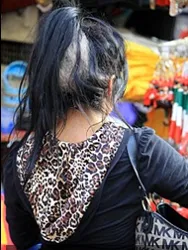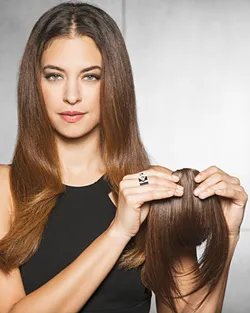
Hair: Tangled Webs We Weave
Introduction
(Image courtesy of Clairol - 2003 - all rights reserved). At the opposite extreme of the scale, dreadlock aficionados live for the chance to wear works of tangled hair art. Some dreaded folks literally spend years twisting and tangling their strands until they have achieved a glorious creation. For long haired men and women, tangled strands can be a trying experience that can potentially threaten the very existence of their cherished tresses. People with naturally long hair have usually spent a lot of time, trouble and money to grow their locks to long or super long lengths. While light to medium tangling can usually be handled relatively easily, severe tangling or matting can become an instant nightmare. Hair can get lightly tangled from a number of common experiences from a restless night of sleeping to daily wear and tear of longer strands. However, the more severe tangling situations can occur from the following situations: 1. Onslaught of Sudden Illness or Health Emergency. My good friend Jennifer Bahney, the long haired founder of Long Hair Lovers, experienced unexpected hair tangling when she was recently rushed to the hospital for an emergency C Section during the delivery of her new daughter. Jennifer reported to me that she had carefully planned for the protection of her classic length long hair by putting it into a tight French Braid before arriving at the hospital. Unfortunately, even with her carefully planning, due to a series of medical complications during her hospital stay, Jen's hair became very tangled. 2. Environmental Conditions
(Image courtesy of Clairol - 2003 - all rights reserved). I also have received emails from tangling victims that experienced hair knotting and related traumas from riding around in a open car on a windy day. If the urge to let you hair blow free in a convertible tempts you, remember that tangles could be your reward for a few minutes of carefree motoring. Keep in mind that hair caught in a sudden rainstorm could also be in danger of serious matting if the strands are not immediately combed out. You may also be prone to sudden tangling if you do not protect your hair from too much sand or surf. When possible keep a cap, scarf or other head covering always available to protect your hair for any type of weather related emergency. 3. Sudden Freak Accidents A HairBoutique.com visitor from Canada reported years ago that her waist length hair had become irreversibly tangled in very sticky insect repellant sticks. Another visitor from the South got her knee length hair tangled in a large fan, which could have been life threatening without the quick action of a watchful spouse. Even clothing can cause tangling. Long strands allowed to continuously brush against knobby or rough fabric may become seriously knotted over time. There have also been reports of serious tangling occurring from amorous activities, if you get my drift, frisky pets and curious babies. 4. Negligence Tangling may occur when the hair is neglected for an extended period of time or is not detangled regularly or properly. Remember to always completely detangle your tresses before you shower, shampoo your hair or log any bed time. Catching a small tangle before it grows into a larger one is always a good plan. 5. Hair Styling Tangles The addition of some types of hair extension systems may result in severe tangling with the host hair if the extensions are not detangled on a daily basis. Tangling may occur because as the natural hair continues to fall out, it may become entangled with the extension strands. The intentional creation of the dreadlocks hairstyle will automatically generate tangles. Hair can also tangle when piled on top of the head during shampoo treatments, around various types of curlers and in hair brushes. 6. Chemical Treatments Tangled hair is sometimes referred to as a birds nest of hair. Hair that is damaged from excessive perming, straightening, coloring or a combination of ongoing chemical treatments may be more prone to forming major tangles. Chemical treatments can actually accelerate the natural weathering of hair strands which causes the hair to become much more prone to knotting. Detangling Tips
(Image courtesy of Clairol - 2003) So what can you do to try and recover from a major matted tangled web of hair: 1. Remain Calm Sometimes a major tangle looks worse than it really may be. Take a deep breath and access the situation. Don't do anything drastic for at least 24 hours if possible. This will give you time to clear your head. 2. Keep The Tangles Dry For many people their first impulse is to just stick their tangled mess under the shower and shampoo. This is actually one of the worst ideas since the combo of the water and the suds can lock the matted mess permanently. Even worse, hair is more vulnerable to ripping and tearing when wet. So even if wetting your tangles helped, which it probably won't, resist because of the potential damage. Although it could take several days while you are detangling, refrain from washing your hair until you have removed all the knots. 3. Soften, Soften, Soften
Some people have reported great results using straight jojoba oil. Others have better results with a spray mixture that they can spray on the tangles as they move through each section. Jennifer Bahney reported that she literally spent days carefully unraveling her post-hospital tangles. Not only did Jen show extraordinary patience and motivation to save her locks, she also had the wisdom to slather her hair with a very thick layer of conditioning and detangling products. Jen's products softened her hair while making it slippery and maybe even a tad slimy, but ultimately completely detangled. Over the years the following products have been reported to me by a number of hair experts as very helpful for detangling: Phytodefrisant, Phyto7, Phyto9 and Aveda Curessence Detangling Spray, Paul Mitchell The Detangler, ARTec Smoothing conditioner. Jen also mentioned Phytodefrisant and Phyto9 as products that are very helpful for detangling. Although I am sure there are many other products on the market that will provide an equally beneficial solution, these products are mentioned the most often. Phyto9 contains Macademia Nut oil which is known for softening and detangling knots. 4. Divide And Conquer Try not to focus on the entire tangled area all at one time. Instead focus your attention on small sections at a time. Clip the sections off that you are not working on to protect them. Study the pattern of your knots and look for areas that are looser and would be potentially easier to work through initially. Believe it or not you should never start without a plan of action. Why? No two tangles are created alike. If you can figure out the mother lode of the main tangle, you can work around any minor or baby tangles that fan out from the major tangle. Although most tangles work best when detangled from the bottom up, some tangles actually require a top down or side to side approach. This is why you should have an idea of how to work on each section. If you are not sure of your tangle configuration, ask a friend to lend you some eyeballs to identify your tangle creation. Start the detangling process by very gently pulling the bottom of the tangled section like a very fine spider web or an old book that can rip. Gentle is the key word. Go slow and be very careful but continue to pull like you are trying to unravel a silken string. Be sure to start from the very tip of your strands and slowly work your way up the strands. Once you have a section detangled, clip it off separately from the rest of the tangles to protect it. 5. Fingers, Knitting Needles & Rat Tails To The Rescue Fingers can actually work as a great natural pick by either breaking through a tough matted section or by helping to gently pull through a knot. Try coating your fingers with your chosen detangler and working your fingers carefully through the targeted section of the tangle. You may be surprised how easily your own fingers can work through knots. Work through each tangle with a steady pressure. Focus on loosening each tangled hair section into a soft loop that will eventually completely open and unravel. For super tight tangles break them apart initially by carefully sliding a knitting needle, hairs tick or rat tailed comb through the knot to loosen it. Be careful when poking a needle or other tool into a super tight matted section not to inadvertently tighten the snarled area. Not only is each tangled case of locks unique, each person is different in their approach. Choose your detangling tools wisely. Although some experts recommend that you only use tools made of stone or ivory, if these do not work for you, use what feels best. Experts caution against using tools with rough or scratchy surfaces. You may find that you have the best luck with a combination of tools ranging from a tortoise like pick or wide tooth comb and a knitting tool or a brush and a crochet hook. Experiment with a range of tools to see what works best. The mother of the son with the reversible dreadlocks actually used a giant pair of surgical tweezers to break apart the knots. 6. Be As Gentle As Possible Whatever tools you utilize, be sure to use the most gentle ones possible. Use high quality brushes (boar's hair), picks and combs. Keep in mind that if you successfully detangle your hair but wind up with 6 inch split ends you will have defeated your purpose. 7. Send Out An SOS If your tangles are near the back of your hair or you can't reach certain sections, send out a call for help to your long hair loving friends. Choose your helper wisely. Be prepared for the idea that some of your friends may encourage you to just cut your hair off and be done with it. If you are determined to give your hair every possible chance to be saved, only request help from friends and professional hair care folks that will be completely sympathetic. Patience challenged people will tire quickly of the tedious task of unraveling strands and may push for the instant gratification of a chop. 8. Log On For Support The Internet has some amazing Messageboard Communities dedicated to help folks survive any type of hair traumas involving every type of hair from long to short and inbetween. These communities are full of loving, caring folks that will support you and offer suggestions. Check out some of these great long hair related Messageboard Sites run by fabulous folks that really love long hair: I visit all of them on a regular basis and they are my favorites for helpful hair advice and encouragement. 9. Feel Free To Scream Detangling a major mess can be extremely frustrating and heart breaking as Jennifer Bahney will tell you. Allow your self adequate time away from the detangling process. If you must go out during your detangling process, clip your hair with "hair friendly" claws or barrettes and use a head covering. If you are committed to removing all the tangles no matter how long it takes, then give yourself permission to get angry and have a good cry or scream. 10. Know When To Quit If you try everything you can think of and the tangles will not budge be prepared to surrender to the scissors. You will have to live with the outcome of the situation so make your decisions based on what you will be happiest with. 11. Do Diligence At The End Whether you lose the tangles to the cutting room floor or some days of hard detangling work, be sure to visit your favorite long hair consultant for a good trim or dusting. Pamper your strands with some special treatment. SummaryThen it comes to tangled tresses, it is always best to avoid them in the first place if you can. When the tangles happen anyway, follow the steps listed above and do the best you can to remedy the situation. If all else fails, forgive yourself for any tangles that have occurred, for whatever reason and promise yourself you will do better next time. And trust me, you will. |
| If you want to talk more about this or other hair care articles on HairBoutique.com or anywhere else, please post a message on HairBoutique.com's Hair Talk Forums.
|
Social Media Network Information
Please follow us on Twitter at: https://Twitter.com/HairBoutique. I look forward to meeting new people from all walks of Twitter and learning from their Tweets.


 To many, the notion of dealing with any type of tangled hair is not relevant because of their current lifestyle. Thousands of hair wearers opt for short to super short chic styles that are wash and wear. Tangles are not in their realm of their hair consciousness.
To many, the notion of dealing with any type of tangled hair is not relevant because of their current lifestyle. Thousands of hair wearers opt for short to super short chic styles that are wash and wear. Tangles are not in their realm of their hair consciousness.  The wind can be the enemy of long haired folks. A HairBoutique.com visitor with waist length hair recently wrote me to ask for suggestions for detangling a major matted mess that occurred when she was caught unexpectedly in a major wind storm. Even though she had her hair tied back, the constant whipping of the wind through her lower tresses rendered them completely matted.
The wind can be the enemy of long haired folks. A HairBoutique.com visitor with waist length hair recently wrote me to ask for suggestions for detangling a major matted mess that occurred when she was caught unexpectedly in a major wind storm. Even though she had her hair tied back, the constant whipping of the wind through her lower tresses rendered them completely matted.  Some major tangles may just not be salvageable. Although I am a huge advocate of giving something your very best shot, I also believe that after a point you have to throw in the detangling pick. Would I spend a week detangling my own hair? Probably. Would I recommend someone else do that? Only if they loved their long hair as much as I love mine.
Some major tangles may just not be salvageable. Although I am a huge advocate of giving something your very best shot, I also believe that after a point you have to throw in the detangling pick. Would I spend a week detangling my own hair? Probably. Would I recommend someone else do that? Only if they loved their long hair as much as I love mine. Reach for your favorite detangling products and apply to your bone dry hair remembering to focus on one section at a time. In the case of tangles, more is always much better than less. Whether you decide to use a spray, cream or other type of detangling formula, slather it on to give your hair maximum softening power.
Reach for your favorite detangling products and apply to your bone dry hair remembering to focus on one section at a time. In the case of tangles, more is always much better than less. Whether you decide to use a spray, cream or other type of detangling formula, slather it on to give your hair maximum softening power. 













